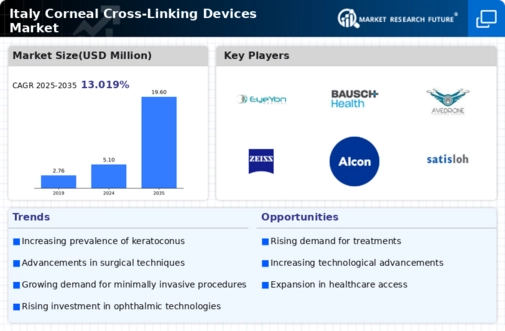Growing Geriatric Population
The aging population in Italy is contributing to the expansion of the corneal cross-linking-devices market. As individuals age, the prevalence of eye disorders, including keratoconus and other corneal diseases, tends to increase. The Italian National Institute of Statistics projects that by 2030, the proportion of individuals aged 65 and older will reach 23%, creating a larger patient base for corneal treatments. This demographic shift is likely to drive demand for effective interventions, including corneal cross-linking. Moreover, older patients often seek solutions to maintain their quality of life, further propelling the market. The anticipated growth in the geriatric population is expected to lead to a market expansion of approximately 12% in the coming years.
Supportive Healthcare Policies
Supportive healthcare policies in Italy are fostering a conducive environment for the corneal cross-linking-devices market. The Italian government has been actively promoting eye health initiatives, which include funding for advanced treatment options. This support is crucial as it encourages healthcare providers to invest in modern corneal cross-linking technologies. Additionally, reimbursement policies for cross-linking procedures are becoming more favorable, making treatments more accessible to patients. As a result, the market is expected to witness a surge in demand, with estimates suggesting a potential increase in procedure volumes by 15% over the next five years. Such supportive measures are likely to enhance the overall growth trajectory of the corneal cross-linking-devices market.
Increased Investment in Eye Care
Increased investment in eye care infrastructure in Italy is a significant driver for the corneal cross-linking-devices market. Both public and private sectors are recognizing the importance of advanced eye care technologies, leading to enhanced funding for research and development. This investment is crucial for the introduction of innovative corneal cross-linking devices and techniques. Furthermore, the establishment of specialized eye care centers is likely to improve access to these treatments, thereby increasing patient uptake. As the market evolves, the influx of capital could potentially result in a market growth rate of around 9% over the next few years. This trend indicates a robust commitment to improving eye health outcomes in Italy.
Rising Prevalence of Keratoconus
The increasing incidence of keratoconus in Italy is a primary driver for the corneal cross-linking-devices market. Recent studies indicate that keratoconus affects approximately 1 in 2,000 individuals, leading to a growing demand for effective treatment options. As awareness of this condition rises, more patients seek interventions that can halt disease progression. The corneal cross-linking procedure has emerged as a preferred treatment, as it strengthens corneal tissue and improves visual acuity. This trend is likely to boost the market, with projections suggesting a growth rate of around 8% annually in the coming years. The rising prevalence of keratoconus, coupled with advancements in cross-linking technology, positions the market for substantial expansion in Italy.
Technological Innovations in Treatment
Technological advancements in corneal cross-linking devices are significantly influencing the market landscape in Italy. Innovations such as accelerated cross-linking techniques and the development of new riboflavin solutions enhance treatment efficacy and reduce recovery times. These advancements not only improve patient outcomes but also attract more ophthalmologists to adopt these procedures. The introduction of minimally invasive techniques is likely to increase the number of procedures performed, thereby expanding the market. Furthermore, the integration of digital technologies in surgical planning and execution may enhance precision and safety, further driving the growth of the corneal cross-linking-devices market. As these technologies evolve, they could potentially lead to a market growth rate of 10% over the next few years.


















Leave a Comment